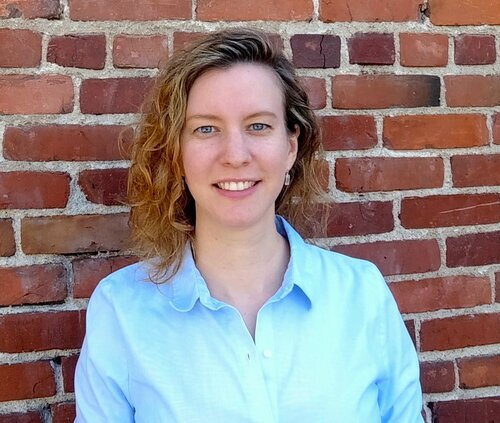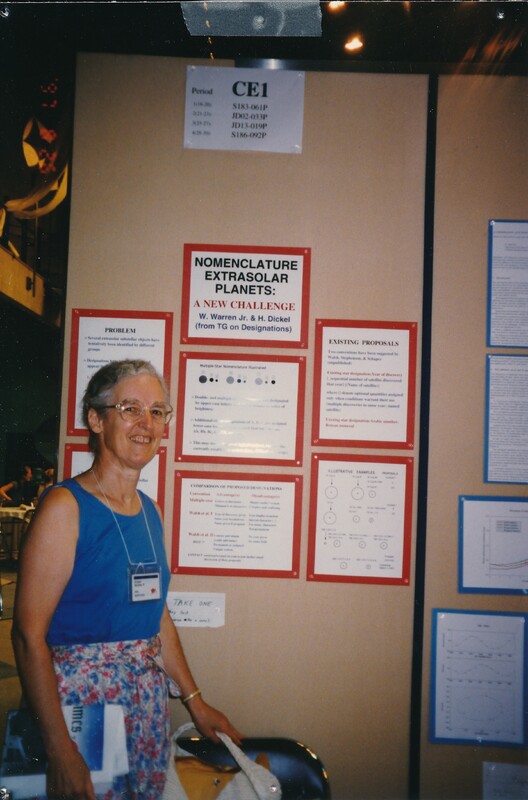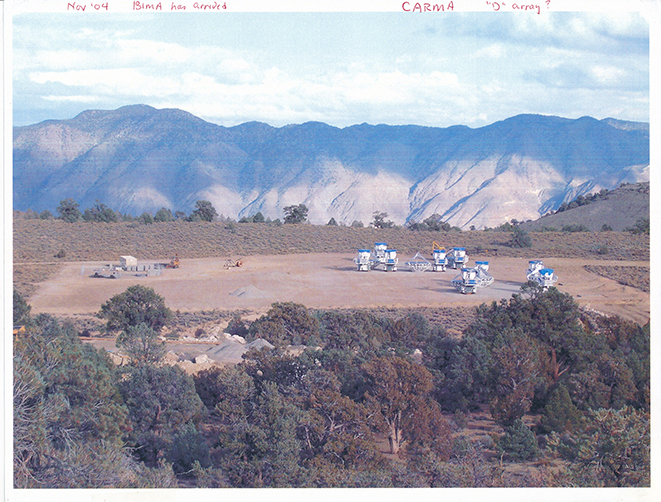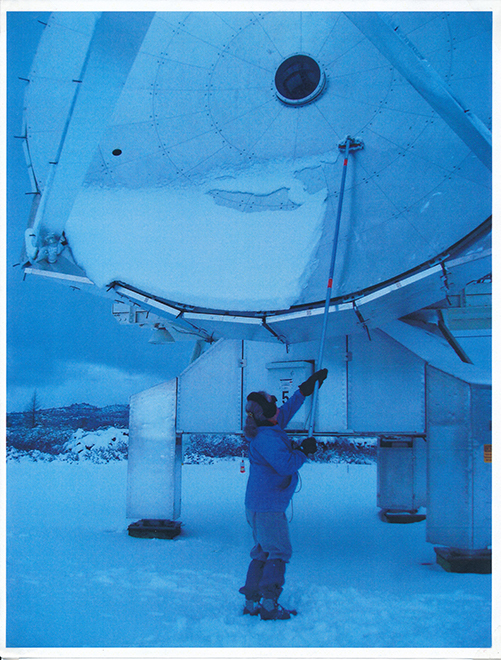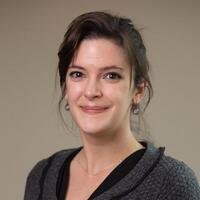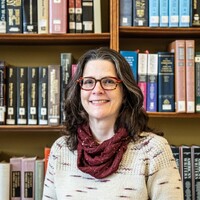February 2023 - Dr. Decker French
Dr. Decker French is an Assistant Professor in the Department of Astronomy in the College of Liberal Arts & Sciences. She joined the University of Illinois in 2020 after serving as a Hubble Postdoctoral Fellow for Carnegie Observatories. Dr. French’s research looks at how galaxies evolve as well as how they co-evolve with their supermassive black holes using time-domain and multi-wavelength observations and has resulted in some groundbreaking astronomical discoveries involving post-starburst galaxies. In 2019, she was awarded the Trumpler Award which is given to a recent Ph.D. recipient whose “research is considered unusually important to astronomy” (Robert J. Trumpler Award).
From the University Archives:
Another woman astronomer who worked at the University of Illinois was Dr. Hélène R. Dickel. Dr. Dickel worked as a researcher from 1965 through 1977 and then as a Research Associate Professor in Astronomy from 1977 until her retirement 2001. Her work focused on the formation of new stars and in 1979 she notably co-discovered the first formaldehyde maser (formaldehyde masers are a rare type of molecular maser flare). Dr. Dickel was additionally a “pioneer in radio molecular spectroscopy using radio aperture synthesis techniques, including making some of the first images of molecular distributions” (UIUC Biography).
Much of Dr. Dickel’s work is done using radio telescopes. The Berkeley-Illinois-Maryland Association (BIMA) Hat Creek Observatory was one of the places Dr. Dickel conducted her research.
As a researcher, Dr. Dickel was not exempt from some of the more manual work on the radio telescopes. This photo from the Hat Creek Observatory shows Dr. Dickel sweeping snow off the dish to ensure it would work properly.
Despite the important work women such as Dr. Dickel or Dr. French are doing, it has unfortunately not always been easy for women to break into astronomy here. In 2005, Dr. Dickel decided to write a reflection “on her employment history at the University of Illinois and how the University has changed in its treatment of women professionals over the years since she first arrived in 1964” (p. 1).
Dr. Dickel describes how she went her whole University of Illinois career without gaining a tenure-track position and had to fund her own research for years through grants. Even to gain a zero-time courtesy appointment (bumping her up to Research Associate Professor in 1977), she was required to provide 12 letters of recommendation despite the normal requirement being only three letters (p. 3).
Later, in the 1980s, when Dr. Dickel tried to use new affirmative action laws to her advantage to gain a position, she was informed the necessary 10% women “quota” was already met because she was incorrectly listed as a “1/2 -time tenure-track female” along with Margaret Hansell who was an astronomy instructor at the time (p. 5).
Dr. Dickel further describes how for ten years her colleagues, friends, and even her husband referred to her as a “non-person” until she finally asked them to stop (p. 5). During the entirety of the 1970s and 1980s, Astronomy at the University of Illinois was without a single tenure-track woman astronomer and had only three women “with non-standard appointments,” two of whom survived on soft-money from their own grants (p. 10).
When Dr. Dickel came to Illinois in 1964, after her husband was hired for a tenure track astronomy position at the University of Illinois, Dr. George C. McVittie served as Head of Astronomy. While much of her treatment throughout her career was less than ideal, Dr. Dickel praises how “‘ahead of the times’ Dr. McVittie was in working for equality for women” (pp. 1-2). Along with arguing to hire her despite nepotism rules in place at the time that “hindered the hiring of spouses,” he also let her keep working when it was discovered by the McKinley Health Center that she was “not hirable” due to her pregnancy (p. 1).
Along with fighting back against sexist policies in place at the time, Dr. McVittie helped to build the University of Illinois’s Department of Astronomy into what it is today and is credited with establishing the University of Illinois’s “modern astronomy department” (“A History of Astronomy at Illinois”). This 1952 article published in the Champaign-Urbana Courier talks about Dr. McVittie’s plan to expand astronomy offerings at the University.
The University of Illinois recruited Dr. McVittie from England in 1951 at the recommendation of notable astronomer and head of the Harvard College Observatory, Dr. Harlow Shapley. Along with other important contributions to astronomy, Dr. Shapley was responsible for estimating the size of the Milky Way Galaxy and our sun’s position within it. In Dr. McVittie’s papers, there are a number of letters sent back and forth between the two astronomers.
In this particular letter to Dr. McVittie from Dr. Shapley written in 1951, Dr. Shapley discusses the forthcoming publishing of his “list of the twenty brightest galaxies” in The American Scientist (p. 1). He also mentions—and includes a copy of—the letter he wrote to the University of Illinois urging them not to shut down the Department of Astronomy. It is his hope that Dr. McVittie “going to Illinois is the first step in something that may go further” (p. 1), which was very much what happened.
Another of Dr. McVittie’s notable contacts was his former lecturer, Sir Charles G. Darwin, who was the grandson of famous biologist Charles Darwin and a renowned mathematical physicist in his own right. In this letter Sir Darwin sent to Dr. McVittie in 1959, he talks about being on a committee with Dr. Harlow Shapley and compliments the University of Illinois and the work Dr. McVittie was doing here.
While there are only two letters held by the University Archives, Dr. McVittie also corresponded with Dr. Albert Einstein whose equations Dr. McVittie worked to investigate throughout his professional career. Originally written in German, the English translation of this letter reads (translation by Kyle Rimkus):
Dear Mr. McVittie:
Thank you very much for the quick and complete explanation, which interested me immensely. If the result of the calculation appears unacceptable because of the smallness of Ro and the largeness of p, it does not seem to me justified in any way to introduce the constant λ, because this is theoretically too arbitrary. Under the prevailing circumstances it seems urgently necessary to subject Hubble's results on the frequency of the nebulae’s dependence on apparent luminosity to a careful review. Because this datum seems to be the most difficult point in the whole consideration. But if this relation was found to be sufficiently secure, then I hardly see any possibility of doubting the bounded nature of space and the resulting ordering of measurements.
With best regards
Your
A. Einstein
It is thus upon the backs of many great astronomers that Dr. French builds her work. While progress has been made, women are still underrepresented in astronomy, making up only 18% of full professors and 23% of total faculty in 2018 which is up from 15% and 19% respectively in 2010 (“Results from the 2018 Academic Workforce Survey”). While still low, both are a major improvement from 1999 when women made up a mere 7% of full astronomy professors (“Women are Creating a New Culture for Astronomy”). Gaining Dr. French as part of the University of Illinois is a good step toward continuing this upward trend.
Sources and Further Reading at the University Archives:
- Hélène R. Dickel Papers, 1963-2005, Record Series 15/3/22, University of Illinois Archives
- Phillips, Dave. “Prof. McVittie to Expand U.I. Astronomy Offerings.” Champaign-Urbana Courier (Illinois), September 8, 1952. Found in the Faculty and Staff Press Release File, 1951-, Record Series 39/1/11, Box 63, Folder George, McVittie, University of Illinois Archive
- George C. McVittie Papers, 1928, 1935, 1938-75, Record Series 15/3/20, Box 1, University of Illinois Archives
Other Resources:
- Astronomical Society of the Pacific. “Robert J. Trumpler Award.”
- Helene R Dickel Phd | Astronomy at Illinois.
- Finkbeiner, Ann. “Women Are Creating a New Culture for Astronomy.” Scientific American, April 1, 2022. https://doi.org/10.1038/scientificamerican0422-32.
- Helba, Cynthia, Anne Marie Porter, Starr Nicholson, and Rachel Ivie. “Women Among Physics and Astronomy Faculty: Results from the 2018 Academic WorkForce Survey. Focus On.” AIP Statistical Research Center. AIP Statistical Research Center, January 1, 2019.
- Svec, Mike. “A History Of Astronomy at Illinois | Astronomy at Illinois.”
